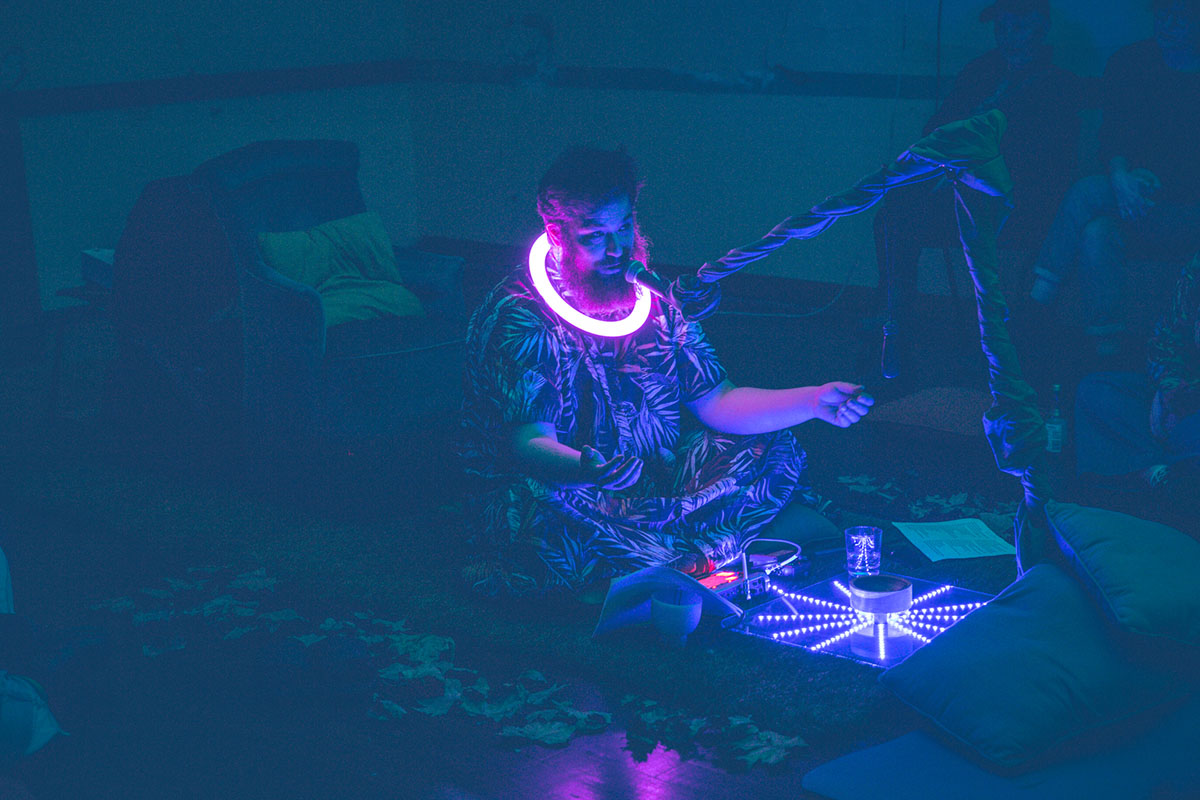
Adhocracy, Vitalstatistix’s experimental hothouse for work in development, is held over four days in Yerta Bulti (Port Adelaide) each year. It’s a rare opportunity for artists from around the country to come together, and for South Australian audiences to witness the alchemy of work in progress. As Artist in Residence at Vitalstatistix, Adhocracy offered a chance for me to speak with artists about the material conditions of their work and the structures that contain and constrain it.
September 2022 marked a return to full capacity for Adhocracy after two years of intense disruption. In 2020, lockdowns and border closures rendered most developments impossible. Instead of hosting twelve projects on site, Vitalstatistix pivoted to supporting 28 projects remotely, with weekly showings online. But by 2021, the organisation was suffering from adaptation fatigue. A fresh wave of restrictions meant that 60% of participating artists could not attend. Public showings had to be cancelled altogether. Announcing the decision, Director Emma Webb wrote:
We don’t believe that yet another swift pivot to an online format would be of benefit to artists or audiences. The priority for our organisation is the mental health of the people we work with. The show does not have to go on.
Programming an event like Adhocracy in these tentative ‘post-pandemic’ months comes with an awareness that artists and arts workers have reached the limits of our endurance. In my conversations, one question became a refrain: ‘How can we keep doing this?’ Covid-19 is still causing cancellations, bouts of serious illness, and chronic conditions. It has profoundly affected the art we make and who gets to make it. It has also rendered visible some of the structures that underpin our labour: material and financial structures, emotional and social systems, and ideas about value, productivity, success and failure.
These themes recur in the twelve projects at Adhocracy and in their methodologies. Artists are engaged in deep reflection. There’s an overdue reckoning with inequality and accessibility, a fresh awareness of safety, harm, and care. ‘Normal’ was already impossible—so what comes next?
Catherine Ryan’s performance lectures interrogate late capitalism’s demands for self-optimisation. Ryan mixes periods of intense work with procrastination and its many hacks. ‘I’ve always had a difficult relationship with time and punctuality,’ she says. ‘What is “wasting time?” We have a puritanism around work... we have internalised the link between self-worth and productivity.’
Is it possible to escape that dynamic as an artist? ‘Meaningful work is a double-edged sword,’ Ryan reflects. ‘We’re told we need to be passionate about work all the time, and there’s a tyranny in that too.’ Ryan’s lectures use what Jack Halberstam might call ‘low theory,’ a blend of philosophy and pop music. ‘I’m drawn to pop songs because they’re forcing us to feel a lot of emotions – they steamroll over us,’ says Ryan. Juxtaposing Beyoncé and Foucault, The Two-Body Problem asks if it’s possible to fulfil the demands now placed on the labouring body.
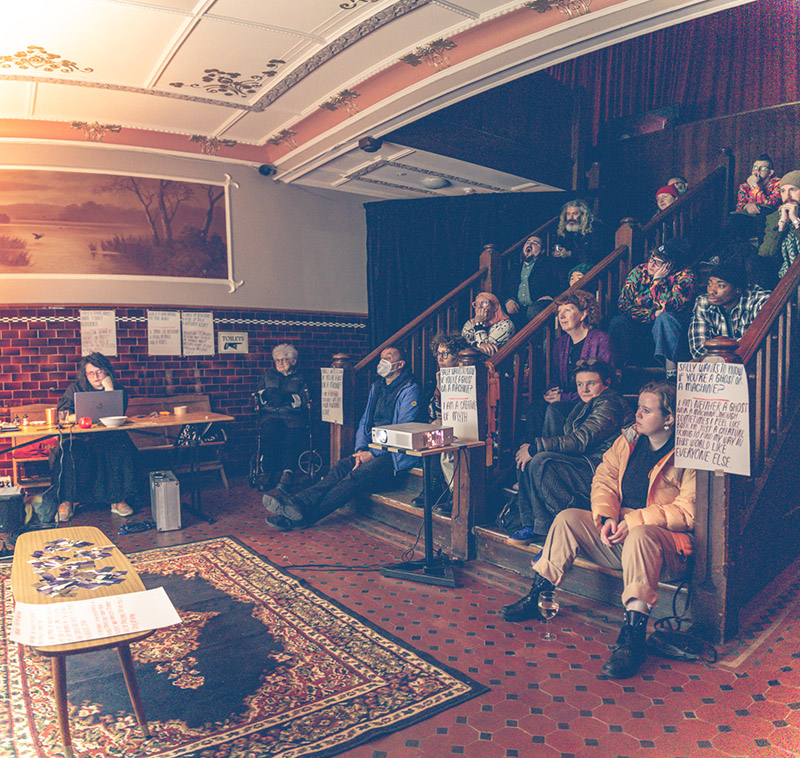
Ryan has embarked on a PhD, in part for the temporary financial security offered by a scholarship, and is ambivalent about the structures that underpin her own labour. Part of the problem is that making art doesn’t resemble traditional images of work. A lecture can involve months of reading, thinking, and repetitive listening. Grant applications are geared towards multiple outcomes, but ‘the making is just a small part of it.’ In contrast, Ryan sees Adhocracy as a micro-culture that values process. ‘Being around other experimental artists and engaged audiences, it encourages experimentation and risk,’ she says.
Death of a Bitcoin Server Repairman considers the absurdities of making art in a world where ‘the canon’ is structured as much by algorithms as it has been by whiteness and patriarchy. When artists bring audiences together in small groups to workshop their knowledge of bitcoin and playwright Arthur Miller, laughter ensues; our grasp of the systems we live in is disastrously limited.
For this group of early career performance makers, deepfakes, AI bots and VR provide ways to explore ambition, success, and the imprisoning weirdness in which they make work. ‘Some people actually achieve something,’ the bitcoin salesman moans to his AI co-star, who glitches back uncertainly, a determining presence that flickers somewhere between human and non-human modes.
Independent producer Caitlin Ellen Moore works long hours on multiple projects, but is often underpaid. She has recently signed up for Australia’s notoriously low unemployment benefits: for the record, Jobseeker is $668.40 per fortnight for a single person; add $50.20 ($718.60 / fortnight for ‘a dependent child or children’, or if aged over 60. In the new system, 100 points’ worth of work-related activities are expected from those on Jobseeker, but making art doesn’t count; nor does collaborating, producing, or facilitating art. Moore plans to escape Centrelink’s punishing requirements by starting her Masters. At twenty-six, she admits that she has accepted an unhealthy level of exhaustion as normal.
‘I read somewhere that it takes three to five years to recover from burnout,’ Moore tells me. ‘I literally don’t have time to do that. At what point did we all decide to live like this?’ Her words echo the question at the heart of Death of a Bitcoin Server Repairman: is this techno-utopia the one that we dreamed of?
‘We can’t escape our cages either,’ muses artist James Nguyen as we visit Fred, the cockatoo that lives in an aviary behind the feed store near Waterside Workers Hall. Nguyen is working on We Loot, a collaboration with his uncle Nguyen Cong Ai about the value of cultural artefacts, history and memory, theft and salvage. His work requires strong collaborative relationships, and he often works with friends and family.
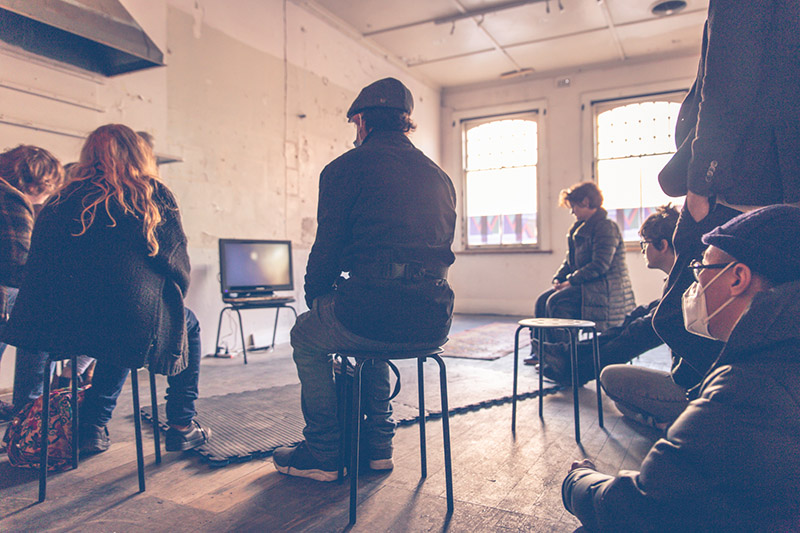
Nguyen’s collaborations carry a belief in the future that he says is often missing in the art world, which can trample friendship, care, and many mid-career artists in its hunger for novelty. ‘A lot of it just comes down to not being a jerk,’ he says. Embedding care for objects, people and stories stems from an awareness of the multiple displacements and extractions that form the context of his work, connecting back to land and the earth.
Nguyen supports himself by working as a pharmacist, which means that he experienced pandemic burnout twice: as an artist, and as a frontline health care worker. He acknowledges the advantage of a supportive partner with a stable job. For Nguyen, many of the issues of being a working artist also come down to land: ‘If we solved the housing crisis, the rest of it wouldn’t be such a problem.’
Frustrated that the structures that are supposed to serve artists – including current governance models – often don’t work in artists’ interests at all, Nguyen still insists artists must maintain a presence at that level. ‘You have to try to work within those systems to make change, even when it feels awkward, or ineffectual,’ he says.
Walking as we talk, we find ourselves wary of leaving the orbit of Vitalstatistix, aware of the conformity required mere streets away. Adhocracy has generated a temporary safety, a social order of its own.
Katie Sfetkidis conducts interviews and discussions with older women and non-binary activists, talking through conflicts and building social memory in We the People. ‘I feel a responsibility to civic participation as an artist,’ says Sfetkidis, who ran for Mayor of Melbourne in 2018.
In the Waterside shopfront, old ideas that art should or can be apolitical are out the window. In their place are colourful posters with slogans like ‘Decolonise feminism’ and ‘Solidarity is our weapon.’ ‘Who cares if it’s didactic? I don’t really give a shit anymore,’ Sfetkidis says. Sfetkidis has moved from technical to creative roles in theatre, and still supports herself with lighting design work. Forging her own practice in 2016, she was politicised by witnessing the rise of Trump.
Running for Mayor meant insisting that artists have a political voice. ‘Artists are serious people and we have more to say about the world than just the art world.’ Having conversations on the campaign circuit with a broad range of people revealed the power of a discursive practice. In a democracy, Sfetkidis says, art can and should provide space for difficult conversations. ‘Let’s all sit in that discomfort together. If we don’t all agree it doesn’t matter.’
Sfetkidis sees the long-term value of her work, but there is a vast difference between her practice and the structure of project funding. ‘The work is a long-range, intergenerational, endless task of weaving society together and learning from each other. The “product” is the relationship, and that’s often invisible.’
Daley Rangi also sees their art as activism; as someone who doesn’t conform to gender norms, they often have no choice. ‘When leaving the house is political, of course your art is,’ says Rangi.
Thinking through the labour of visibility and representation and the expectations that are placed on some artists to engage in (unpaid) diversity work has led Rangi to explore debt and obligation in
I Don’t Owe You. While there are levels of choice in gender presentation, some choices are read as drag, or entertainment; others seem to generate violent responses, where strangers become combatants. ‘Where does the violence come from? It comes from this idea that we owe them something. I don’t know why there’s this expectation of debt.’
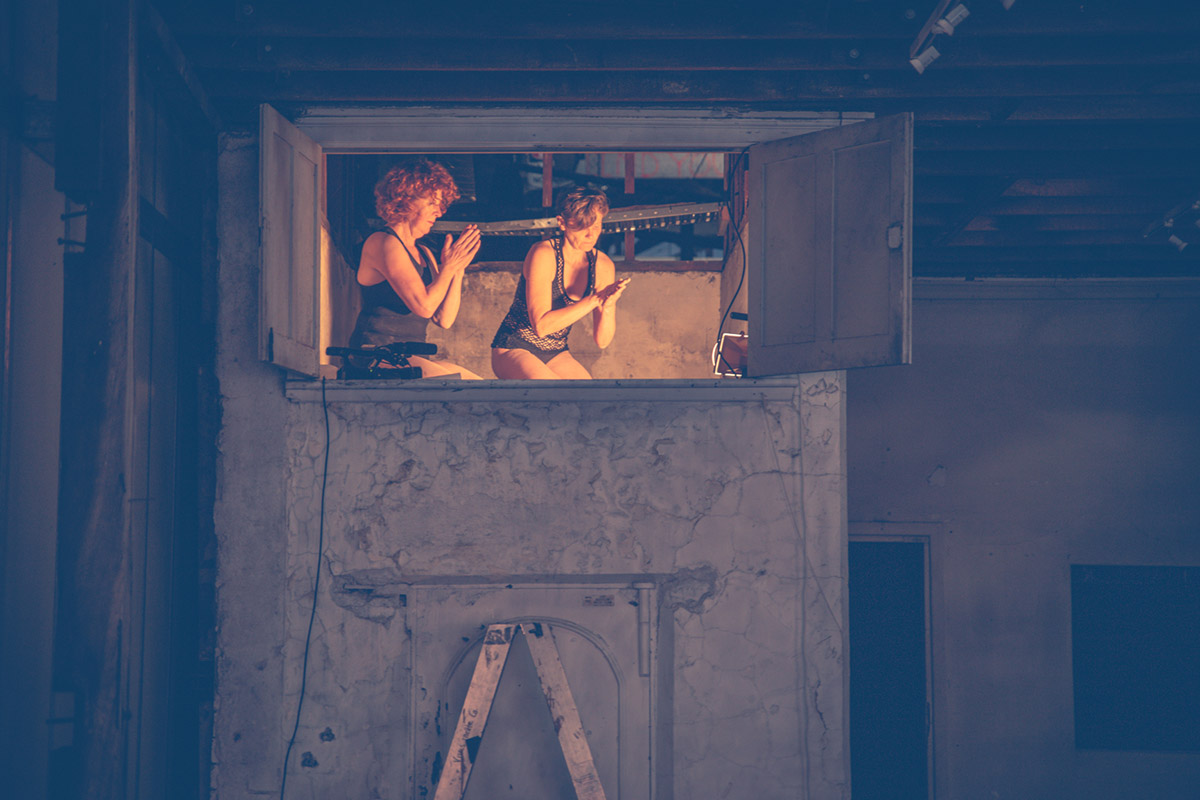
For Rangi, pursuing violence as a function of a hidden economy has led to an interrogation of transactions in the arts. They are frustrated that arts organisations are still accepting fossil fuel funding, for example. ‘We’re always operating within some extractive process,’ they say. ‘We’re in a world where art is extractive: come see me tell a story about my trauma.’ Rangi questions these power dynamics with audiences in I Don’t Owe You. ‘You don’t always have to say yes to other people, or to give them all of yourselves. Care can be about boundaries, too.’
Katy B Plummer’s quest to address debt has led to working with ghosts. At Adhocracy, she’s speaking with a chatbot oracle about the problems of intergenerational responsibility; together they will generate a libretto. Margaret and the Grey Mare investigates ancestral legacies, including the obligations that are visited upon Plummer as a beneficiary of colonisation and white supremacy.
Plummer, who makes zines and ran a bookshop for a time, is fascinated by the economics of the art world and its hierarchies, and how mechanical reproduction intersects with the spiritual. ‘Art has gotten very focused on legitimacy,’ she reflects, often at the expense of artists. ‘Art and the New Age are in a shadowed place with the market. Both have this dirty relationship with capitalism.’
Care for one’s ancestral legacy is the kind of work that the wage system has little time for, and oracles have their own transactional protocols that predate capital. Is it possible to make reparations through art, or to do the work of justice? Plummer shakes her head. ‘It needs to go back into the material world as well. I can’t just build a career on the sins of my ancestors without trying to address the material inequality they helped forge.’
Dianne Reid and Cinzia Schincariol are established artists whose collaborative practice has been remade by distance. In The Practice of Being Close, Reed’s cinematic choreography, working with cameras and editing, becomes an investigation of proximity. ‘The camera frees you from geographic borders,’ says Reed.
Australia’s border control response to the pandemic meant that Schincariol has only recently been able to return here. She sought refuge in an artists’ community in Europe which ran on direct barter. Living outside the market economy was liberating. ‘I found a profound relief there,’ she says. ‘My whole experience of time changed. So now I’m asking: why do we speed up again?’
Like so many artists, both Reed and Schincariol generate income from diverse sources like teaching, disability support, health research and public events. Schincariol tried working in the private sector, but ‘it was so taxing and draining, it couldn’t coexist [with dance].’ Reed made a decision early in her career: ‘I promised myself I would never do any work unrelated to my dance practice—so you get really creative about what your practice is.’
Established in their careers and approaches, both artists are looking for ways to scale down: one-on-one interactions, intimate audio walks, and deeper conversations with audiences. It’s challenging in a world where ‘audience engagement’ is always measured in numbers. Adhocracy offers a space to test these scaled-back forms.
For Daisy Sanders and Joshua Pether, mutual care takes priority. Both artists live with chronic pain and disability. At Adhocracy, this means working remotely, with Sanders on site at Harts Mill and Pether collaborating via video feed. ‘My dance practice is grounded in rest and deep knowledge of the nervous system,’ says Sanders, who spent years recovering from ME/CFS (Myalgic Encephalomyelitis/ Chronic Fatigue Syndrome). ‘Being a dancer allowed me to get well; it became my work.’ Sanders’ practice is built on work/rest cycles; for many, she says, these cycles look more like hyperactivity/burnout. ‘The world wants us to move faster than our bodies.’
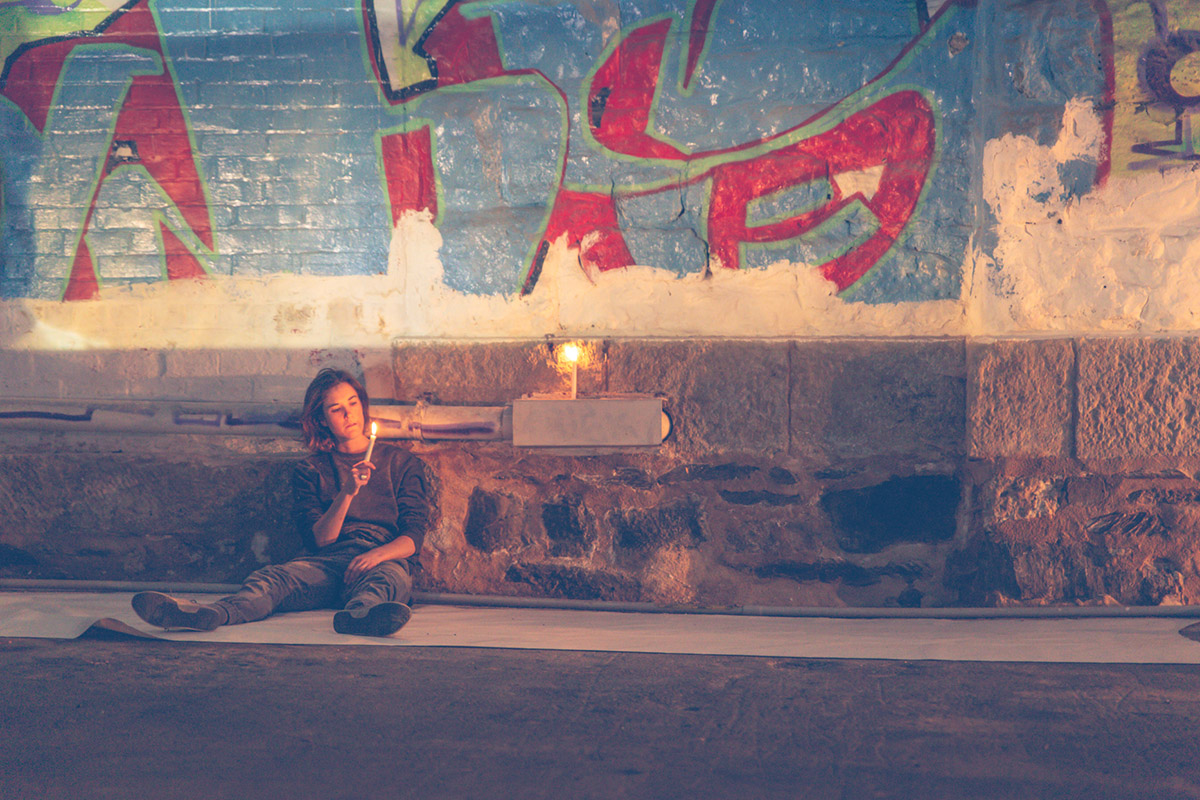
Sanders and Pether find ways to resist patriarchal and colonial temporality in their long-term collaboration, but sustaining this approach is a financial challenge. ‘Grants determine the work,’ says Sanders, who applies for at least 25 gigs a year. ‘You have to know how to speak that dialect. But you also have to know the work outside of that platform.’ For a while, she tried to step away: ‘What’s going to happen if I just be an artist for a year?’ Though the hustle can be paused, it’s hard to escape.
Undoing Kingdoms creates a reverent atmosphere. As Sanders moves in the dimly lit space, Pether’s projection moves behind, beside, and sometimes with her. As part of the showings, audiences engage in reflective discussion; ritual practice becomes a way to build community.
Playwright Peter Beaglehole became acutely aware of precarity when he underwent significant surgery in his late twenties. ‘It shouldn’t take a tumour in your spine to radicalise you,’ he says. ‘Time became really important.’
Calendar Days is a black comedy set in a speculative workplace grounded in the petty daily realities of 21st Century labour and an environment Beaglehole describes as ‘a judgy Centrelink hellscape.’ It’s inspired by testimonials and by economist Guy Standing’s notion of the existential insecurity of gig workers, who lack an ‘occupational narrative.’ Such occupational narratives can be illusory for artists: the bias towards the new, and the myth of overnight success, misrepresent the realities of careers that are often slow, difficult, and unseen. Beaglehole says investment in the longevity of artists is lacking in traditional theatre. ‘You end up in the indie space, but that’s not necessarily comfortable for more conventional theatre practitioners either.’
The industrial conditions of theatre vary from project to project depending on funds and circumstances. Traditional union structures struggle to adhere in independent spaces where voluntarism is common. ‘The reliance on goodwill and unpaid labour makes it borderline impossible to keep doing this past your twenties.’
Awarded the Harts Mill residency, the Calendar Days team chose to work part-time in order to pay everyone the award rate. This meant working less hours, but more carefully. ‘The working methodology is as important as the aesthetic,’ says Beaglehole. His new mantra is a semi-ironic response to the problem of chronic burnout: ‘Do less, care less.’
‘A lot of artists are saying to ourselves, “I’m going to play a different game and play on my terms,”’ Beaglehole explains. He relishes this task of reimagining the possibilities of work. ‘That’s part of our job as artists: here’s a little model universe we can play in, and maybe we can see the world differently.’
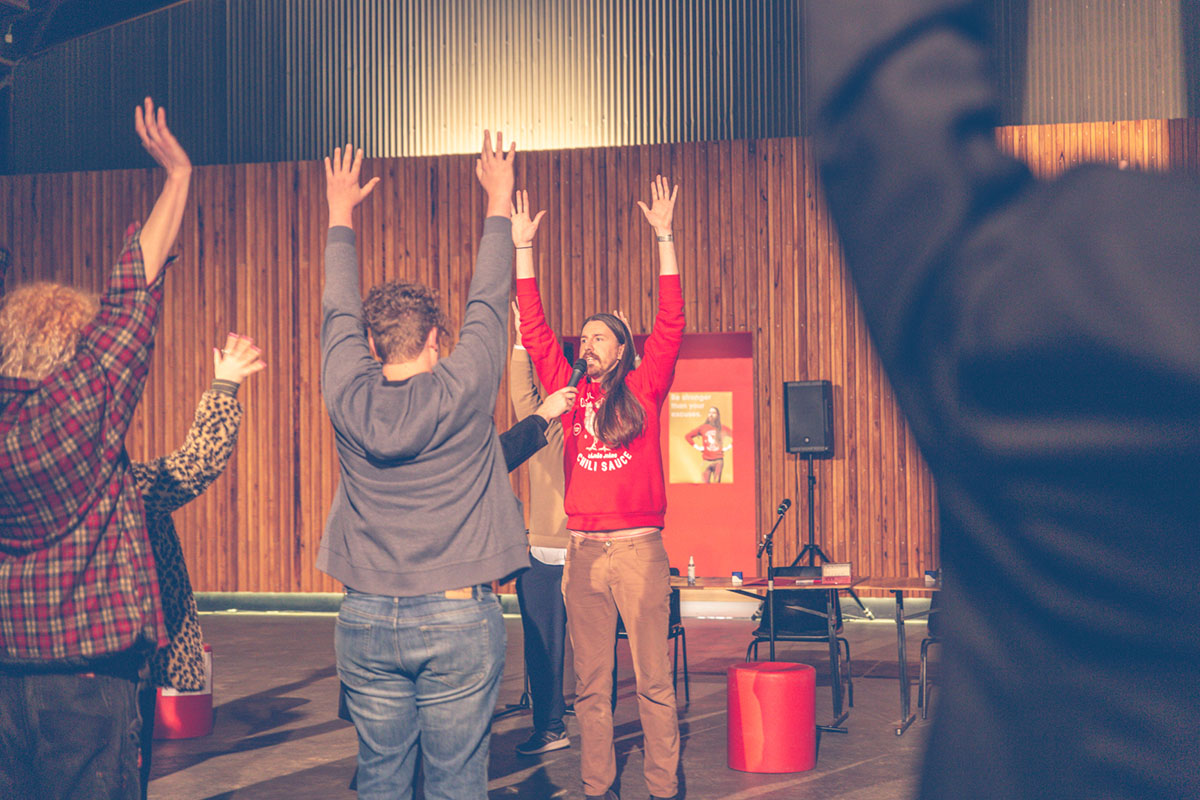
It’s already happened, we’re just in the past also addresses precarity, fragility and care. Emily Parsons-Lord, Shan Turner-Carroll and Solomon Thomas share an interest in behind-the-scenes aesthetics, film effects, and the untrained body. Working outside their areas of expertise, the process and the resulting work emphasise shared vulnerability and interdependence against a backdrop of escalating catastrophes.
The last few years has led each of these artists to reconsider the value of their work. ‘Covid made me realise we’re all dispensable,’ Parsons-Lord says. Accepting that things will never be easy can be liberating: ‘there’s a ceiling in the arts even if you’re successful, so you might as well do what excites you.’
Working with film loops offers a contrast to the time pressure of live performance and exhibition deadlines. Turner-Carroll recalls being incapacitated after four exhibitions in one month: ‘I was lying in the bath searching for sad songs on Spotify, thinking: this is what success looks like.’ Although they live near each other—Parsons-Lord and Turner-Carroll in the same building, and Thomas one suburb away—it’s been impossible to find time together until now, supported by Adhocracy, to play and experiment, to test ideas on audiences. ‘It’s also the money, you know,’ Turner-Carroll adds. ‘We couldn’t make it work without the money.’
The grants given to artists for Adhocracy are small—a few thousand dollars—and are often spent covering costs. Most participants have other jobs in retail, teaching or health care. Flexible shifts accommodate the demands of creative practice, but those jobs are also among the lowest paid in the country.
The churn of competitive application processes and constant productivity is contributing to burnout and attrition at all levels of practice. We are at risk of losing—are already losing—a generation of artists, particularly those already marginalised, including disabled, working class and regional artists. Making it work isn’t working.
Like other industries, the arts and culture sectors are reckoning with insecure work, overwork and inequality. Many are reflecting on their working conditions, with arts advocates arguing for shorter weeks and fairer workloads through initiatives such as Kate Larsen’s ‘Less is Necessary’ campaign.[1] Submissions to the National Cultural Policy inquiry emphasised the crisis of labour in the arts, exacerbated by a chronically underfunded environment. There is some optimism that the new policy will offer concrete change. As the National Association for the Visual Arts (NAVA) argues, an acknowledgement of the artist as worker promises a fundamental shift in approach.[2]
Artists absorb and reflect social ideas about success, failure and the value of their labour. They are well aware of the effects of all this on their wellbeing. ‘Constantly having to bridge the gaps between projects, it’s really stressful,’ said one. ‘The mental health impacts are huge.’ Long-term solutions are needed to support artists throughout their careers, not just from project to project. ‘I’m staring down the barrel of what does a career in the arts look like if I’m still in this position in twenty years’ time, and it’s terrifying,’ said another.
More funding from a variety of sources is the first answer, but it’s certainly not the only one. Many of the artists at Adhocracy spoke about grants with ambivalence. Some were uncomfortable with the fact that grants determine what gets made and privilege those who speak the language. ‘We should be funding artists, not projects,’ was a common remark.
Many expressed enthusiasm for a Universal Basic Income. In Ireland, a Basic Income for the Arts pilot scheme began this year, and is being hotly discussed along with other European models such as France’s Intermittent du Spectacle. So far, the Greens are the only Australian political party with a liveable income policy. But artists are not waiting for politicians to catch up; they are already shifting their practice.
Creating the conditions to make work isn’t just about productivity; it also means providing space for co-operation and solidarity. Projects cross-pollinate and influence each other. Artists come into conversation, share knowledge and skills, play together. Art springs from relationships: between artists, with place, with communities and audiences and histories. In this collectivism, perhaps there’s a clue to the source of conservative hostility.
But while Adhocracy allows artists space and time to expand, it also runs on the exhaustion of Vitalstatistix staff, who work long (often invisible) hours to make it happen. Like many art events, it depends on the creative use of limited resources and the contribution— and passion—of volunteers. The glow of possibility at Adhocracy is shadowed by a sense of what might be possible if there were enough resources, time, staff, energy, money, to support artists to work in the slower, deeper, more relational and more just ways that so many arts workers are seeking.
With its long-range ‘Bodies of Work’ inquiry, Vitalstatistix is amid its own process of reflection, looking for ways to centre care. ‘Mutual aid should be core business for arts and culture organisations,’ says Emma Webb. With limited institutional support, experimental work is among the most precarious and at risk of art forms. Over four days, Adhocracy provides a place where it can flourish; a place where the change we need is not only discussed, but enacted. Artists, beyond exhausted, are reaching for transformation.
Footnotes
